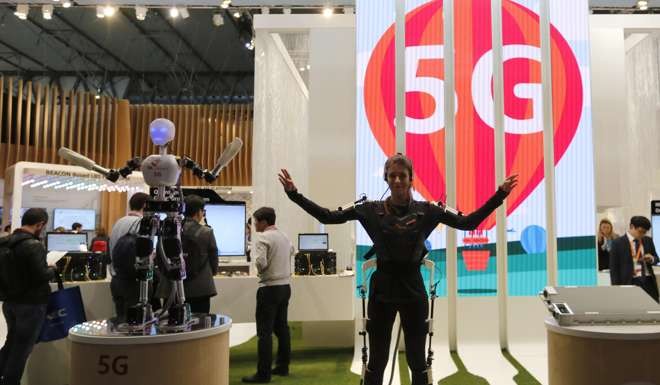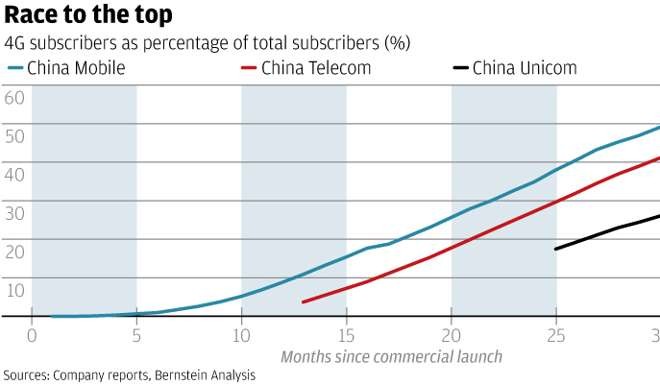
China to roll out 5G broadband mobile equipment trials across 100 cities
High-speed 5G networks can theoretically transmit data 20 times faster than current 4G speed, with less than one tenth of the latency

China, home to three of the world’s largest mobile network operators, has started conducting trials of so-called 5G telecommunications equipment that will span more than 100 cities, as it aims to get a head start in the race to lead the next generation of cellular phone systems.
High-speed 5G networks can theoretically transmit data 20 times faster than current 4G speed, with less than one tenth of the latency, or the time for a data request to receive a reply. The 5G technologies being tested include massive multiple-antenna systems capable of handling more users and increased capacity to support greater mobile data usage, according to Bernstein Research.
China, with the world’s largest 4G market at 1.3 billion users at the end of 2015, is the only country with sufficient scale to “make or break” a new global 5G standard, something industry leaders say is necessary to optimise the efficiency of the technology when it becomes widely used, said Bernstein’s senior analyst Chris Lane.
“We believe ‘China Inc’ has a strong vested interest in ensuring a significant amount of Chinese technology is embedded in the [5G] standard - finally freeing them of their dependency on foreign technology and the need to pay royalties,” Lane said in a report.
Almost 30 per cent of China’s 1.3 billion mobile phone users are on 4G networks, according to the Ministry of Industry and Information Technology (MIIT), which regulates the sector.

The International Telecommunications Union, part of the United Nations, expects network deployments to begin in 2020 soon after the standards are set for 5G, technically known as IMT-2020.
The consensus among global telecoms industry leaders is that a single standard - a unified set of industry benchmarks - would be enormously beneficial.
“The cost of having different standards is high for the industry,” Wang Zhiqin, director of the Institute of Communications Standards Research at the China Academy of Information & Communications Technology said during the InnoTech Expo in Hong Kong.
Given the advantage of being an early mover, all network operators will have an incentive to invest in 5G ahead of others
She was referring to the additional expense and complexity that went into supporting multiple standards for network equipment and smart devices in the 3G and 4G mobile eras.
David Dai Shu, spokesman for Shenzhen-based telecommunications equipment maker ZTE, told the South China Morning Post that China Mobile alone was planning “pre-5G trials in more than 100 cities across more than 20 provinces.”
China Unicom and China Telecom may also be undertaking some preparation, although no details were available, Dai said, adding that Unicom had signed a cooperation agreement with ZTE in August related to 5G research.

China Mobile, the world’s largest wireless network operator by revenue and subscribers, has said previously that it plans to roll out its 5G network service in 2020.
Bernstein forecasts that China Mobile will reach 543 million 4G users by the end of this year, up from 466.64 million as of August 31.
A spokeswoman for China Mobile in Hong Kong said on Monday that the company was doing its own 5G research and preparation, but that the scale of investment was very low at this early stage.
Daiwa Capital Markets analyst Ramakrishna Maruvada said in a report last week that China Telecom’s own 5G preparation was underway even as industry discussions are ongoing on setting standards.
“As the technology standards are likely to be set by 2018, 5G investments [for China Telecom] could happen from 2019 and 2020,” Maruvada said.
Separately, the MIIT completed the first phase of government testing on key wireless technologies for future 5G networks early last month.
“Compared with the previous eras when we just built our technology on the framework designed by foreign companies, [Chinese telecommunications companies] are playing a leading role globally.”
Lane predicted fierce competition among individual service providers to become early adopters of the technology.
“Given the advantage of being an early mover, all telecommunications network operators will have an incentive to invest in 5G ahead of others,” Bernstein’s Lane said.
China Mobile, for example, benefited from being ahead in 4G deployment on the mainland. The operator has more profitable 4G users than Unicom and China Telecom, which made up for its weaker position during the 3G era when it shouldered the cost of building a government-backed domestic mobile standard.
Xu Li, an analyst at Soochow Securities, said the government would be happy to see a unified 5G standard because Chinese companies currently have stronger research and development capabilities than many of their overseas counterparts.
“Compared with the previous eras when we just built our technology on the framework designed by foreign companies, [Chinese telecommunications companies] are playing a leading role globally,” Wang added.
Last month, the Post reported that Japan’s SoftBank Corp was testing 5G-ready equipment from ZTE and Huawei Technologies at more than 100 urban base stations across the country.
Japan is planning a large-scale 5G network deployment in time for the Tokyo Olympic Games in 2020.
What is 5G and who will use it?

What is 5G?
5G stands for 5th generation mobile networks and represents the upcoming mobile telecommunications standards beyond today’s 4G networks.
5G technology is expected to have massive capacity, allowing an increase in the number of simultaneous connections with extremely little lag and significantly improved network speeds.
What is the difference between the different generations of mobile networks?
The first generation mobile network, 1G, allowed users to make calls wirelessly.
2G networks allowed users to send texts via mobile networks, and 3G networks allowed connection to the mobile Internet.
When 4G technology was introduced, users saw a significant increase in upload speeds, allowing users to upload large files and stream video via 4G mobile networks with little interruption.
What are the advantages of 5G?
5G technology goes beyond providing your smartphone or computer with a mobile internet connection. That’s because 5G networks’ massive capacity, which allows up to a million connections per kilometre square, means that the smart cities and the Internet of Things can now also connect wirelessly to mobile networks.
Unlike on 3G or 4G, users will no longer experience difficulty in connecting to a mobile network in crowded places such as at a packed outdoor concert when using a 5G network.
5G has also been touted by experts to provide speeds that are up to 100 times faster than current 4G networks. Estimates suggest that 5G users would be able to download a full-length, high-definition movie in one second.
Furthermore, 5G technology is expected to come with an ultra-low latency rate of less than 1
millisecond. In comparison, current 4G networks have a latency of 50 milliseconds.
Latency is defined as the amount of time it takes for a packet of data to get from one point to another.
The ultra low latency also means that mission-critical tasks, such as remote surgeries or even autonomous driving, can be performed on a 5G network with precision.
5G’s low latency is expected to help virtual and augmented reality take off, since users will be able to wirelessly stream high-definition videos on a mobile network to their virtual reality headsets with almost no lag.
Who sets the standards for 5G?
ITU, which stands for the International Telecommunication Union, is a United Nations agency that co-ordinates global telecommunication operations and services, including setting 5G standards.
However, organisations such as 3GPP assist with helping to create and co-ordinate the standards for mobile communication networks, and produce
When will 5G become commercially available?
5G technology is expected to be commercially rolled out from 2020 - although South Korea is expecting to introduce the technology in 2018 during the Winter Olympics.
Which countries are leading 5G development?
Users get to grips with new 5G phones at the CEBIT exhibition in Las Vegas
China, Japan and South Korea are at the forefront in developing 5G mobile technology, according to mobile body GSMA. These countries already have a high level of 4G adoption and government support in developing 5G, putting it ahead of North America and Europe.
In China, state-run telecommunications giants China Mobile, China Unicom and China Telecom will begin 5G testing next year together with telecommunications vendors such as Huawei and ZTE, which are already developing the necessary infrastructure for the upcoming network.
In contrast, Europe and the US has been lagging behind Asia in developing 5G due to economic uncertainty and slower deployment of 4G networks throughout the region.


